technical specifications Seat Mii 2013 Workshop Manual
[x] Cancel search | Manufacturer: SEAT, Model Year: 2013, Model line: Mii, Model: Seat Mii 2013Pages: 306, PDF Size: 4.3 MB
Page 105 of 306
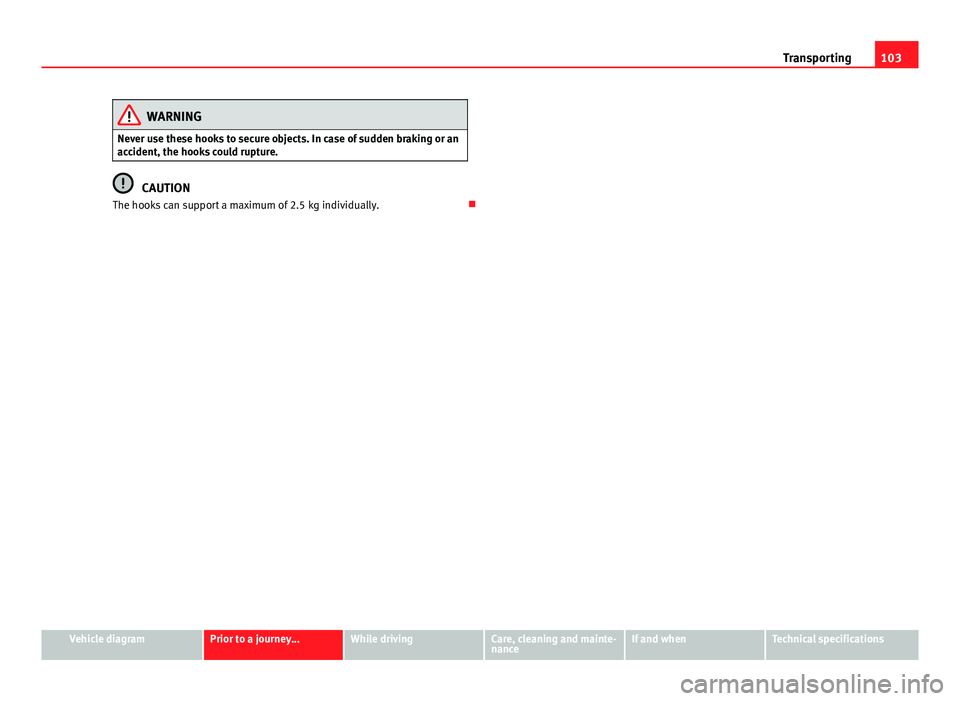
103
Transporting
WARNING
Never use these hooks to secure objects. In case of sudden braking or an
accident, the hooks could rupture.
CAUTION
The hooks can support a maximum of 2.5 kg individually.
Vehicle diagramPrior to a journey...While drivingCare, cleaning and mainte-
nanceIf and whenTechnical specifications
Page 107 of 306

105
Transporting
Securing the base supports and roof carrier system
Fig. 72 Attachment
points for the basic sup-
port and the roof carrier
system
The mounts are the basis of a complete roof carrier system. Special fixtures
must then be added in order to safely transport luggage, bicycles, skis, surf
boards or boats on the roof. The suitable accessories can be acquired at
SEAT dealerships.
Securing the base supports and roof carrier system
The roof carrier system must always be installed exactly according to the in-
structions provided.
The front attachment opening can be found in the lower part of the sides of
the roof and are fixed with plastic bolts ⇒ Fig. 72 (left magnified image).
The openings can only be seen with the door open. The markings for attach-
ment in the lower part are found in the upper part of the rear side windows
⇒ Fig. 72 (right magnified image).
The base support should only be fitted to the points indicated in the dia-
gram.
WARNING
If the base supports and the roof carrier system are incorrectly fitted or
used in an unsuitable manner, the entire system could break free causing
accident and injury.
● Always take the manufacturer assembly instructions into account.
● Only use base supports and roof carrier systems that are not dam-
aged and are correctly fitted.
● The base support should only be fitted to the points indicated in the
diagram ⇒ Fig. 72.
● Secure the base supports and roof carrier system correctly.
● Check the screw fittings and attachments before driving and after a
short distance. During each long journey, check the attachments during
every break.
● Always fit the roof carrier system correctly for wheels, skis and surf-
boards, etc.
● Never change or repair the basic supports or roof carrier system.
Note
Read and take into account the instructions included with the roof carrier
system fitted and keep them in the vehicle.
Loading the roof carrier system
Loads can only be correctly secured when the roof carrier system is correctly
fitted ⇒ .
Maximum authorised roof load
The maximum authorised roof load is 50 kg. The roof load includes the
weight of the base support, the roof carrier system and the load being
transported ⇒
.
Vehicle diagramPrior to a journey...While drivingCare, cleaning and mainte-
nanceIf and whenTechnical specifications
Page 109 of 306
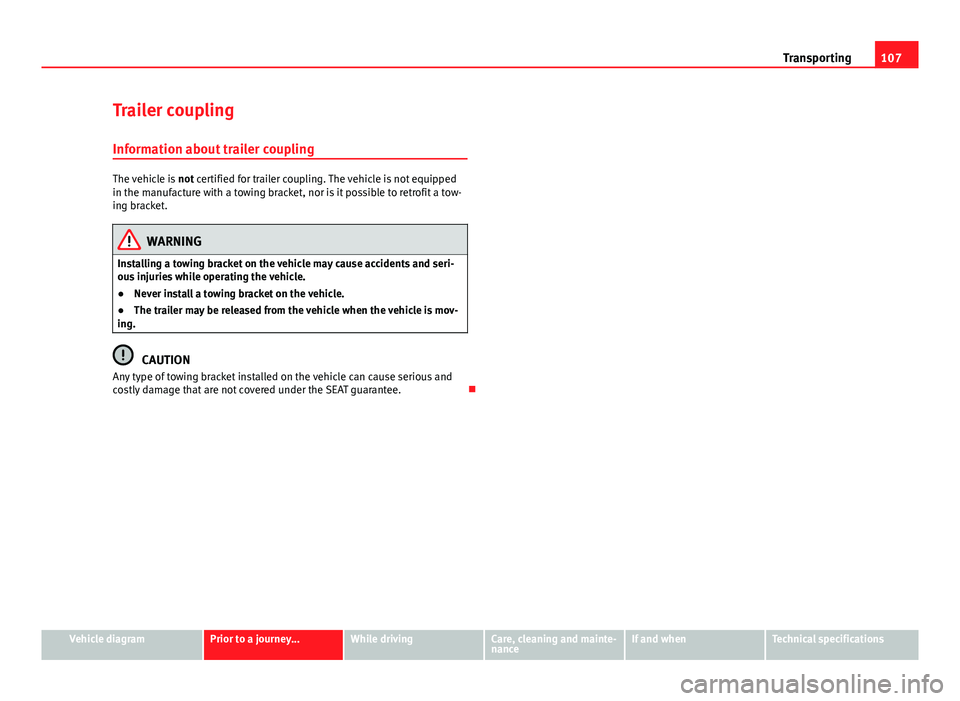
107
Transporting
Trailer coupling Information about trailer coupling
The vehicle is not certified for trailer coupling. The vehicle is not equipped
in the manufacture with a towing bracket, nor is it possible to retrofit a tow-
ing bracket.
WARNING
Installing a towing bracket on the vehicle may cause accidents and seri-
ous injuries while operating the vehicle.
● Never install a towing bracket on the vehicle.
● The trailer may be released from the vehicle when the vehicle is mov-
ing.
CAUTION
Any type of towing bracket installed on the vehicle can cause serious and
costly damage that are not covered under the SEAT guarantee.
Vehicle diagramPrior to a journey...While drivingCare, cleaning and mainte-
nanceIf and whenTechnical specifications
Page 111 of 306
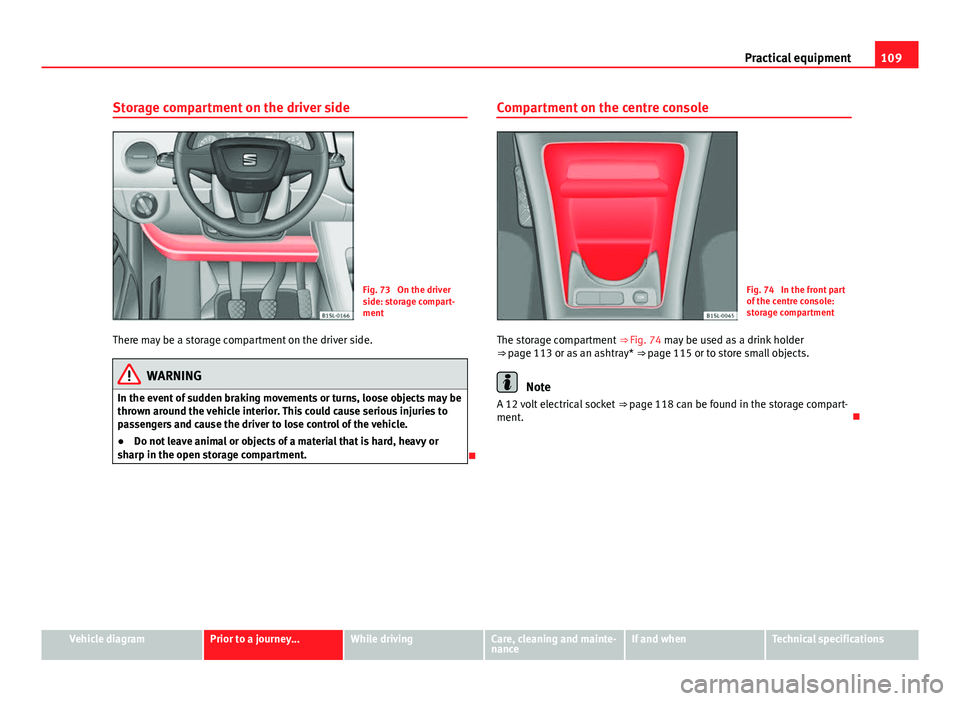
109
Practical equipment
Storage compartment on the driver side
Fig. 73 On the driver
side: storage compart-
ment
There may be a storage compartment on the driver side.
WARNING
In the event of sudden braking movements or turns, loose objects may be
thrown around the vehicle interior. This could cause serious injuries to
passengers and cause the driver to lose control of the vehicle.
● Do not leave animal or objects of a material that is hard, heavy or
sharp in the open storage compartment.
Compartment on the centre console
Fig. 74 In the front part
of the centre console:
storage compartment
The storage compartment ⇒ Fig. 74 may be used as a drink holder
⇒ page 113 or as an ashtray*
⇒ page 115 or to store small objects.
Note
A 12 volt electrical socket ⇒ page 118 can be found in the storage compart-
ment.
Vehicle diagramPrior to a journey...While drivingCare, cleaning and mainte-
nanceIf and whenTechnical specifications
Page 113 of 306
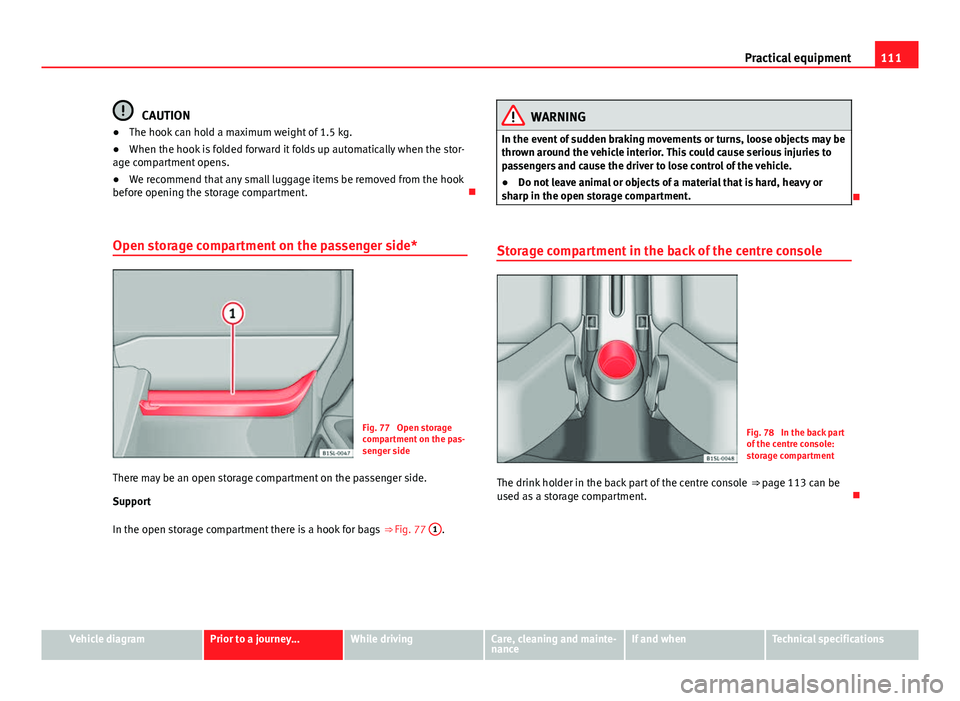
111
Practical equipment
CAUTION
● The hook can hold a maximum weight of 1.5 kg.
● When the hook is folded forward it folds up automatically when the stor-
age compartment opens.
● We recommend that any small luggage items be removed from the hook
before opening the storage compartment.
Open storage compartment on the passenger side*
Fig. 77 Open storage
compartment on the pas-
senger side
There may be an open storage compartment on the passenger side.
Support
In the open storage compartment there is a hook for bags ⇒ Fig. 77 1
.
WARNING
In the event of sudden braking movements or turns, loose objects may be
thrown around the vehicle interior. This could cause serious injuries to
passengers and cause the driver to lose control of the vehicle.
● Do not leave animal or objects of a material that is hard, heavy or
sharp in the open storage compartment.
Storage compartment in the back of the centre console
Fig. 78 In the back part
of the centre console:
storage compartment
The drink holder in the back part of the centre console ⇒ page 113 can be
used as a storage compartment.
Vehicle diagramPrior to a journey...While drivingCare, cleaning and mainte-
nanceIf and whenTechnical specifications
Page 115 of 306
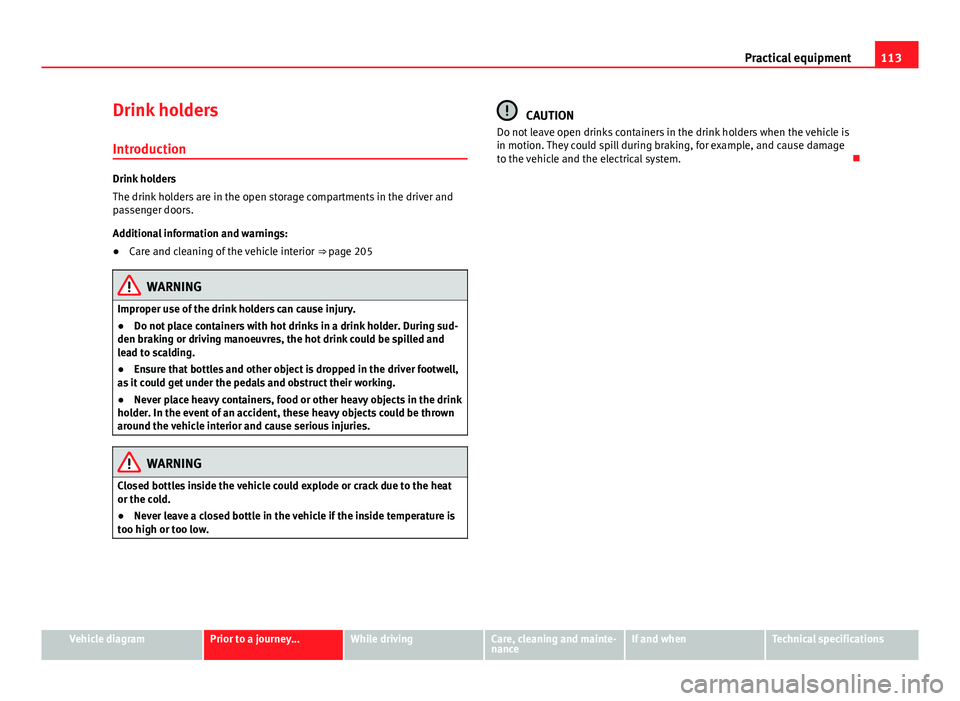
113
Practical equipment
Drink holders
Introduction
Drink holders
The drink holders are in the open storage compartments in the driver and
passenger doors.
Additional information and warnings:
● Care and cleaning of the vehicle interior ⇒ page 205
WARNING
Improper use of the drink holders can cause injury.
● Do not place containers with hot drinks in a drink holder. During sud-
den braking or driving manoeuvres, the hot drink could be spilled and
lead to scalding.
● Ensure that bottles and other object is dropped in the driver footwell,
as it could get under the pedals and obstruct their working.
● Never place heavy containers, food or other heavy objects in the drink
holder. In the event of an accident, these heavy objects could be thrown
around the vehicle interior and cause serious injuries.
WARNING
Closed bottles inside the vehicle could explode or crack due to the heat
or the cold.
● Never leave a closed bottle in the vehicle if the inside temperature is
too high or too low.
CAUTION
Do not leave open drinks containers in the drink holders when the vehicle is
in motion. They could spill during braking, for example, and cause damage
to the vehicle and the electrical system.
Vehicle diagramPrior to a journey...While drivingCare, cleaning and mainte-
nanceIf and whenTechnical specifications
Page 117 of 306
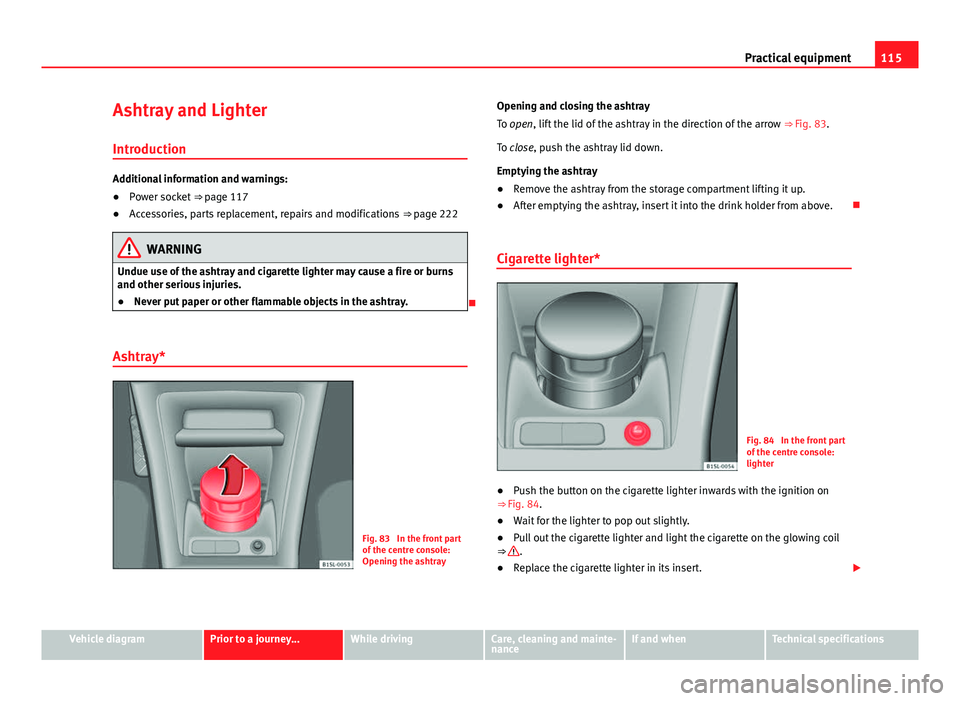
115
Practical equipment
Ashtray and Lighter
Introduction
Additional information and warnings:
● Power socket ⇒ page 117
● Accessories, parts replacement, repairs and modifications ⇒ page 222
WARNING
Undue use of the ashtray and cigarette lighter may cause a fire or burns
and other serious injuries.
● Never put paper or other flammable objects in the ashtray.
Ashtray*
Fig. 83 In the front part
of the centre console:
Opening the ashtray Opening and closing the ashtray
To open, lift the lid of the ashtray in the direction of the arrow
⇒ Fig. 83.
To close, push the ashtray lid down.
Emptying the ashtray
● Remove the ashtray from the storage compartment lifting it up.
● After emptying the ashtray, insert it into the drink holder from above.
Cigarette lighter*
Fig. 84 In the front part
of the centre console:
lighter
● Push the button on the cigarette lighter inwards with the ignition on
⇒ Fig. 84.
● Wait for the lighter to pop out slightly.
● Pull out the cigarette lighter and light the cigarette on the glowing coil
⇒
.
● Replace the cigarette lighter in its insert.
Vehicle diagramPrior to a journey...While drivingCare, cleaning and mainte-
nanceIf and whenTechnical specifications
Page 119 of 306
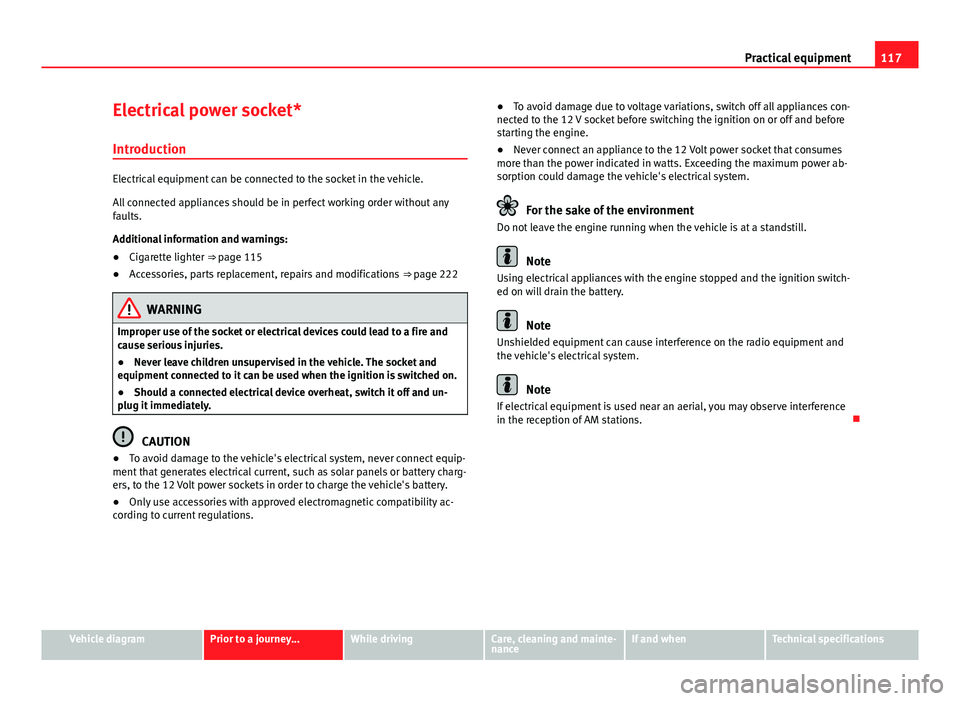
117
Practical equipment
Electrical power socket* Introduction
Electrical equipment can be connected to the socket in the vehicle.
All connected appliances should be in perfect working order without any
faults.
Additional information and warnings:
● Cigarette lighter ⇒ page 115
● Accessories, parts replacement, repairs and modifications ⇒ page 222
WARNING
Improper use of the socket or electrical devices could lead to a fire and
cause serious injuries.
● Never leave children unsupervised in the vehicle. The socket and
equipment connected to it can be used when the ignition is switched on.
● Should a connected electrical device overheat, switch it off and un-
plug it immediately.
CAUTION
● To avoid damage to the vehicle's electrical system, never connect equip-
ment that generates electrical current, such as solar panels or battery charg-
ers, to the 12 Volt power sockets in order to charge the vehicle's battery.
● Only use accessories with approved electromagnetic compatibility ac-
cording to current regulations. ●
To avoid damage due to voltage variations, switch off all appliances con-
nected to the 12 V socket before switching the ignition on or off and before
starting the engine.
● Never connect an appliance to the 12 Volt power socket that consumes
more than the power indicated in watts. Exceeding the maximum power ab-
sorption could damage the vehicle's electrical system.
For the sake of the environment
Do not leave the engine running when the vehicle is at a standstill.
Note
Using electrical appliances with the engine stopped and the ignition switch-
ed on will drain the battery.
Note
Unshielded equipment can cause interference on the radio equipment and
the vehicle's electrical system.
Note
If electrical equipment is used near an aerial, you may observe interference
in the reception of AM stations.
Vehicle diagramPrior to a journey...While drivingCare, cleaning and mainte-
nanceIf and whenTechnical specifications
Page 121 of 306
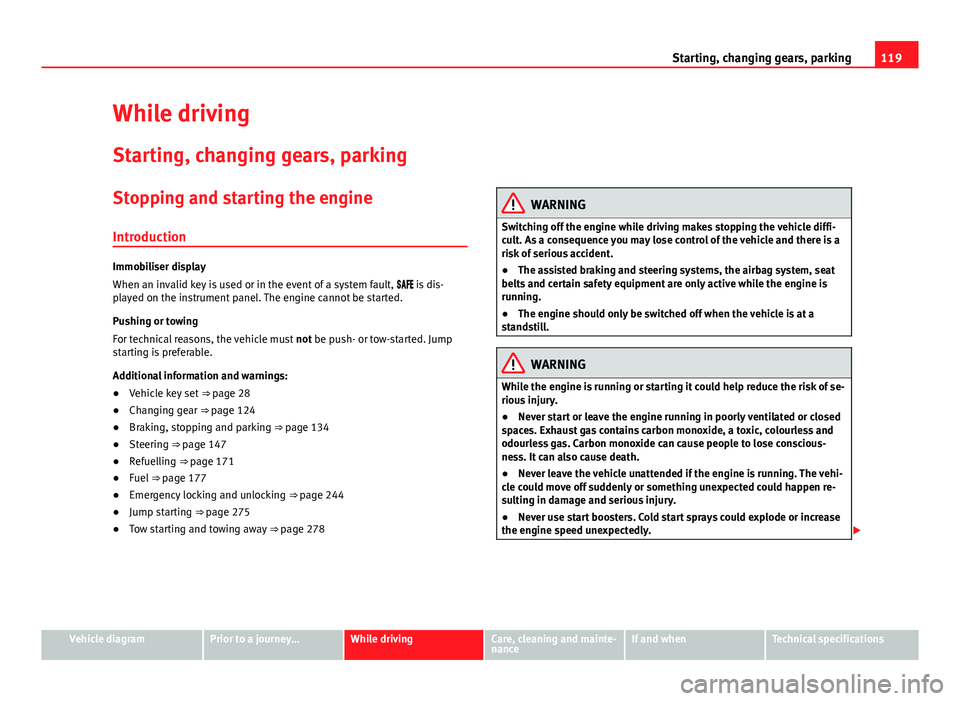
119
Starting, changing gears, parking
While driving
Starting, changing gears, parking
Stopping and starting the engine Introduction
Immobiliser display
When an invalid key is used or in the event of a system fault, is dis-
played on the instrument panel. The engine cannot be started.
Pushing or towing
For technical reasons, the vehicle must not be push- or tow-started. Jump
starting is preferable.
Additional information and warnings:
● Vehicle key set ⇒ page 28
● Changing gear ⇒ page 124
● Braking, stopping and parking ⇒ page 134
● Steering ⇒ page 147
● Refuelling ⇒ page 171
● Fuel ⇒ page 177
● Emergency locking and unlocking ⇒ page 244
● Jump starting ⇒ page 275
● Tow starting and towing away ⇒ page 278
WARNING
Switching off the engine while driving makes stopping the vehicle diffi-
cult. As a consequence you may lose control of the vehicle and there is a
risk of serious accident.
● The assisted braking and steering systems, the airbag system, seat
belts and certain safety equipment are only active while the engine is
running.
● The engine should only be switched off when the vehicle is at a
standstill.
WARNING
While the engine is running or starting it could help reduce the risk of se-
rious injury.
● Never start or leave the engine running in poorly ventilated or closed
spaces. Exhaust gas contains carbon monoxide, a toxic, colourless and
odourless gas. Carbon monoxide can cause people to lose conscious-
ness. It can also cause death.
● Never leave the vehicle unattended if the engine is running. The vehi-
cle could move off suddenly or something unexpected could happen re-
sulting in damage and serious injury.
● Never use start boosters. Cold start sprays could explode or increase
the engine speed unexpectedly.
Vehicle diagramPrior to a journey...While drivingCare, cleaning and mainte-
nanceIf and whenTechnical specifications
Page 123 of 306

121
Starting, changing gears, parking
WARNING
Unsuitable or careless use of the vehicle key could result in serious in-
jury.
● Always take all the keys with you whenever you leave the vehicle. The
engine could accidentally be started and electrical equipment such as
the windows could accidentally be operated resulting in serious injury.
● Never leave children or disabled people alone in the car. They could
be trapped in the car in an emergency and will not be able to get them-
selves to safety. For example, depending on the time of the year, temper-
atures inside a locked and closed vehicle can be extremely high or ex-
tremely low resulting in serious injuries and illness or even death, partic-
ularly for young children.
● Never remove the key from the ignition if the vehicle is in motion. The
steering may lock and it will not be possible to turn the steering wheel.
Note
● If the key is left in the ignition lock with the engine off for long periods,
the vehicle battery will run flat.
● In vehicles with automatic gearbox the ignition key can only be with-
drawn with the selector lever in position P. In this case, press and release
the selector lever locking button.
Starting the engine
Complete operations only in the sequence given.
1.Press the brake pedal and keep pressed until step 5 has been completed.
1 a.In vehicles with a manual gearbox: Press the clutch pedal all
the way and keep pressed until the engine starts.
Complete operations only in the sequence given.
2.Put the gearbox lever in neutral or the selector lever in posi- tion P or N.
3.Turn the key in the ignition lock to position ⇒ Fig. 86 2; do
not press the accelerator.
4.When the engine has started, release the key in the ignition lock.
5.If the engine does not start, stop the process and try again af-ter one minute.
6.Release the handbrake when you want to begin driving⇒ page 134.
WARNING
Never leave the vehicle unattended if the engine is running. The vehicle
could move off suddenly, especially if it is in gear, resulting in an acci-
dent and serious injury.
WARNING
Cold start sprays could explode or cause a sudden increase in the engine
speed.
● Never use start boosters.
CAUTION
● An attempt to start the engine while driving or starting the engine imme-
diately after turning it off can cause damage to the engine or starter motor.
● When the engine is cold, avoid high revs and heavy acceleration and do
not make the engine work hard.
● Do not push or tow start the engine. Unburnt fuel could damage the cat-
alytic converter.
Vehicle diagramPrior to a journey...While drivingCare, cleaning and mainte-
nanceIf and whenTechnical specifications